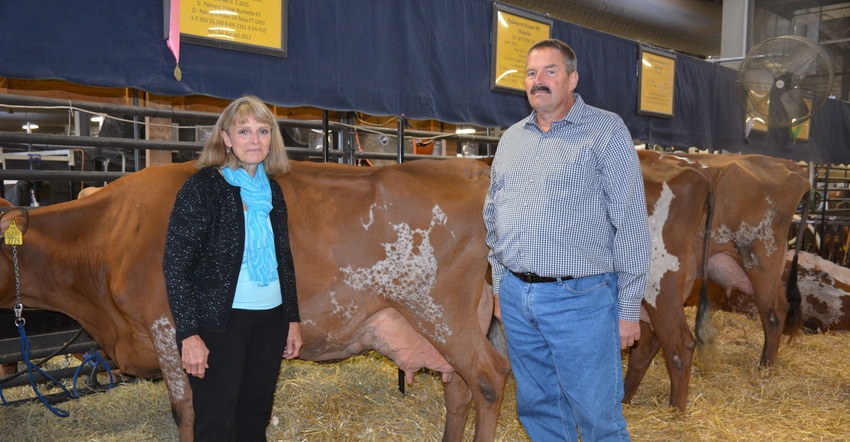October 15, 2019

Some people say that it’s best to not do business with family. After all, not all family members get along.
Siblings Ralph Shank and Mary Shank Creek might have their differences, but they run their farm with one goal in mind: running a good business.
Palmyra Farm, their operation in Hagerstown, Md., has become well-known in the dairy business for top-quality Ayrshires and genetics.
At World Dairy Expo, the siblings were named Distinguished Breeders by the National Dairy Shrine, the first brother-sister combo to win the award.
“It's a very humbling experience to be thought of in those terms," Ralph says. “Then you look at some of the previous winners; to be even thought of in those categories, you wonder why.”
Distinguished history
According to the National Dairy Shrine newsletter, Palmyra Farm has placed 77 Ayrshire bulls into AI units. Their Palmyra Tri-Star Burdette, a high production and type bull, has 6,500 daughters in over 1,600 herds and has been prominent in moving the Ayrshire breed forward.
The pair have had three grand champions at World Dairy Expo as well as winning premier breeder 11 times and premier exhibitor nine times.
They are the first Ayrshire herd in the country to use embryo transfer and have exported embryos to 10 other countries.
Splitting the duties
The two run Palmyra Farm along with help from their spouses, who also work off-farm jobs.
“It’s a joint management system. Daily work is broken up evenly,” he says. Mary handles the calving while both take turns on milking. Ralph does most of the feeding.
“We know how each aspect of the dairy works,” she says.
Other family members are involved. Ralph’s son, Mark, feeds cows in the morning; Mary’s husband does relief milking along with Ralph’s wife; and Mary’s son, Evan, does farm work when he’s home.
Smaller is better
Like most dairy farmers, the past couple of years have been a struggle, with last year being especially difficult for the siblings.
They decided it was the right time to downsize the herd from 200 cows down to around 60 cows and 130 young stock. They’ve built the milking herd back up to 100 cows with 20 of their animals and 20 boarded animals.
“The downsizing I guess was kind of a necessity point," he says. “We’re not in a position to get bigger from a land size or facility standpoint.”
“Getting bigger wasn’t working,” she says.
The farm includes 400 acres, which they rent out to other farmers and then buy the feed for the dairy. The two say they haven’t large-scale crop work in 15 years, which has allowed them to focus on the cows.
Still, at 200 cows, it was getting too hard. Mary says she doesn’t regret downsizing. Physically, she feels better and has found more time to do things outside the dairy.
“I really think I'm enjoying it. There is more time to do things for ourselves and our family that we missed out on before," she says.
“We’ve made it another year,” she says, laughing.
All about Ayrshires
The “complete cow” is what the siblings strive to breed.
“She has to be functionally correct, she has to milk. If they don’t milk, they don’t stay no matter who they are,” Ralph says.
Ayrshires are the foundation of the farm and go back three generations with a few Holsteins mixed in.
Developing a higher genetic-value animal is important, Mary says, as it brings more value and marketable not only to the farm’s animals, but also the breed.
“If you want your product to have value, then the breed has to have value,” he says, adding that her father was once president of the Ayrshire Breeders Association and was a board member for many years.
“So, we have picked up and carried on the legacy. We give our cows value because we've been lucky with our breeding decisions,” she says. “If the breed itself is not respected and developed, then the product doesn't have reciprocal value to it. So, the breed has to be respected and gain esteem and have other people develop interest in it to try to elevate the value of your cows.”
You May Also Like




